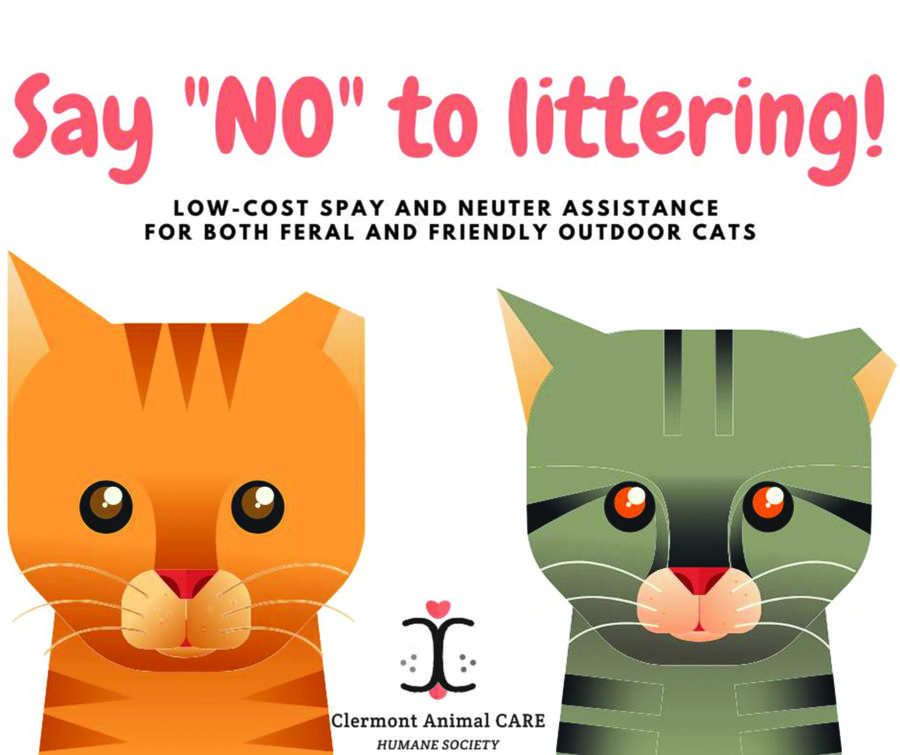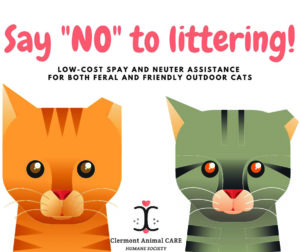
By Brett Milam
Editor
The village of Batavia is “beset by an infestation of feral cats,” according to a letter council sent to Clermont County Public Health. 
Council approved the letter at its June 8 meeting and sent it the following day to Dr. Janet Rickabaugh, president of the Clermont County Board of Health, with Julianne Nesbit, health commissioner, copied.
Dennis Nichols, village administrator, wrote the letter, saying the issue of feral cats is that “many of them are diseased.”
“Aggravating the problem, several Batavia residents are feeding the cats, magnifying the nuisance and attracting a related infestation of skunks, raccoons, and vermin,” he said.
Nichols said residents have brought to council evidence of hardships related to the feral cats, including veterinary costs for treating household pets that have been infected by them, and associated fees.
“Mayor [John] Thebout and the Batavia village council receive complaints of loss of pets to disease, damage to gardens and other property, and peril to children, as well as to pets,” the letter continued. “Medical specialists can describe the pathologies, a subject beyond my competence, but the threat to public health is obvious.”
As a solution, the village suggested a “roundup of stray cats and citing the people feeding them to court for creating a public nuisance.”
Short of that, Nichols said the CCPH could ordain a roundup and enjoin the human vectors from aggravating the contagion.
“The village will cooperate in any reasonable way to enforce a remedy, and we can discuss means to pay the costs of policing and remedying this plague,” he said.
In a follow-up, Jason Garrison, council member, told The Sun via email that council had been working for “quite some time to understand how to deal with the issue of feral cats.”
“Members of council and our legal director have reviewed Batavia’s code of ordinances but can’t quite agree that there’s language that addresses the issue of the large number of feral cats and the residents that are feeding and/or providing shelter for them on their properties,” he said.
He echoed the letter, as it regarded complaints from residents to council.
“We’ve received complaints of a resident that is feeding many feral cats at their house. Multiple neighbors report seeing 50 [plus] cats at that property,” he said. “These same neighbors complain of cat feces in their yards, general odor of cat feces in their neighborhood, and wild animals that are being attracted to food being left out for feral cats.”
In addition, there’s been complaints of a citizen that drives a vehicle “around town and puts out food for feral cats at several locations.”
Trash has also been left behind at the feeding locations.
“When residents bring concerns to Batavia Village Council, it is our duty to take them seriously,” Garrison said. “After considering all their testimony at the June council meeting, we felt it was necessary to seek assistance from Clermont County Public Health on this issue.”
While Garrison said he supported the rights of responsible pet ownership, what is happening in this situation is “clearly not that.”
“When this type of activity affects adjacent properties and property owners that have no interest in supporting the feral cat population of Batavia, it’s time to take a serious look at how to address the problem,” he said.
Keith Robinson, communications coordinator with CCPH, confirmed to The Sun that they had received the letter, which was also discussed at the Board of Health’s June 10 meeting. Robinson provided the response letter Nesbit sent to the village.
In short, Robinson said, “We do not do anything with feral cats unless it would be considered a public health nuisance (for example, a person living with many cats in unsanitary conditions).”
Nesbit expanded in her letter, saying, “Public Health does not trap any animals. Public Health is involved in disease transmission with animals, but it is primarily limited to rabies exposures from animals to humans.”
She explained when a rabies exposure happens — an animal bites a human — CCPH follows-up with a quarantine of the animal to ensure it’s not communicable and/or the bite victim, if the animal cannot be quarantined or tested.
“Rabies is not very prevalent in Clermont County; the last positive case we had was in 2017 in a bat,” she said.
Nesbit also asked staff to pull data on bite reports in the village to see if there were any recent increases.
“There were no bites occurring from cats in April, May, or June to date,” she said. “There were four in March, three of which were owned, and only one was a stray.”
In a response email, Nichols said, “Their [CCPH] approach is to confine their interest to rabies, which is rare, and avoid the multitude of diseases cats carry, such as leukemia, trots, and cat scratch fever, which are awfully hard to control.”
Nevertheless, Nesbit, in her letter, said they understand the concern and agree that residents feeding the cats will only exacerbate the problem.
She ended the letter with resources the village could look into for assistance, including Ohio Alleycat Resource & Spay/Neuter Clinic, and the United Coalition of Animals, a nonprofit spay and neuter clinic.
Both organizations are located in Cincinnati.
She also recommended reaching out to the Clermont Animal CARE Humane Society for any additional recommendations from them.
It so happens, Clermont Animal CARE recently launched a new community cat program, which they say is a solution to the issue of community cats that isn’t rounding them up. Instead, the program offers “low-cost spay and neuter assistance for both feral and friendly outdoor cats.”
Since adoption and housing in a shelter isn’t feasible since feral cats do not want to come inside and do not do well in shelters, the solution is to “trap, neuter, return,” the program stated on its website.
The site continued, saying TNR is the only “effective and humane solution to the problem of feral cat overpopulation.”
“With TNR, community cats are caught in humane traps, transported to the vet, and spayed and neutered and vaccinated,” the site said. “Once they have recovered from surgery, they are returned to their outdoor home. TNR helps cats to be happier and healthier – and keeps communities happier and healthier, too!”
Such vaccinations help to prevent the development and spread of diseases in groups of outdoor kittens, the program site added.
The program seeks to as a bridge to provide “community-based solutions,” with resources, such as traps, equipment and training. They also will provide transportation to and from our veterinary partners.
For more information about the program, visit https://bit.ly/2YCYV5I.
In an email response to a resident, who mentioned the new community cat program, Nichols said Clermont Cares is a special-purpose organization with its own goals and agenda.
“The Village of Batavia is an Ohio Village with a mandate under the Ohio Constitution and statutes and therefore has broader goals and a different agenda,” he said. “Although Mayor Thebout and member of the Village Council share and support many goals of Clermont Cares, they will establish their own means of serving the people of Batavia.”
Before this program, one member of the village has been engaging in “TNR” for more than 20 years.
Trudy Howe, 82, said she has always been an animal lover.
“When I moved into the village about 30 years ago, I had almost 20 cats just in my area running loose. Some of the cats were healthy and some were sick,” she said. “I started taking care of the sick ones. It was then I realized that many were not fixed.”
So, Howe fed them in order to get them to trust her so she could catch them and get them the medical help they needed.
“Without medical help, the cats were spreading illness to the rest of the population. I have worked with many vets and organizations for vouchers to help pay for the spay/neutering. I have paid for the rest,” she said.
Howe also echoed Ohio Alleycat that a better term for these animals is “community cats,” because they aren’t wild; they just haven’t been socialized.
“This name also includes the many we see in the village — abandoned, stray, and those who are pets that live outside,” she said. “I think the term feral is used arbitrarily. Some people call them nuisance animals; they are not, they are community cats.”
Howe said she thinks the village needs to work with these community partners, like Ohio Alleycat, to engage in TNR.
“There are numerous issues in the village in regards to cats. People get a cat, don’t get it fixed and then it runs outside. People also leave their cats when they move,” she said. “The problem is not the cats. It is the people who are not responsible pet owners.”
Howe said some people have confronted her about making the cat issue worse, but she said she’s actually decreasing the population by gaining the trust of the animals, catching them, fixing them, and getting them medical help.
“I do not leave dishes or food behind. I wait for them to eat or return within 20 minutes to collect the bowls,” she said.
